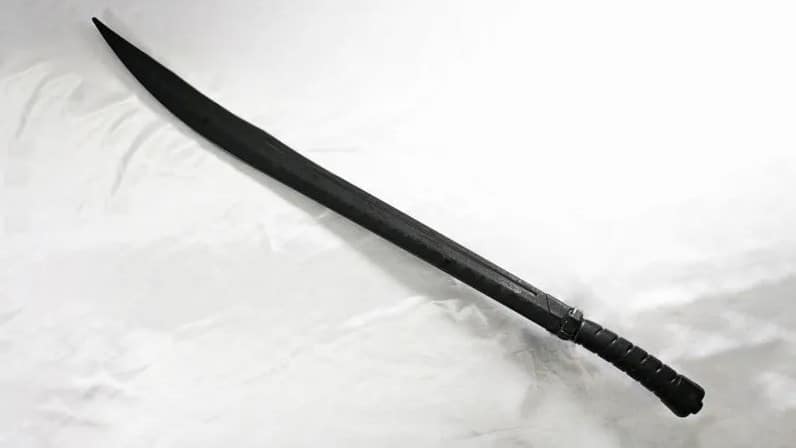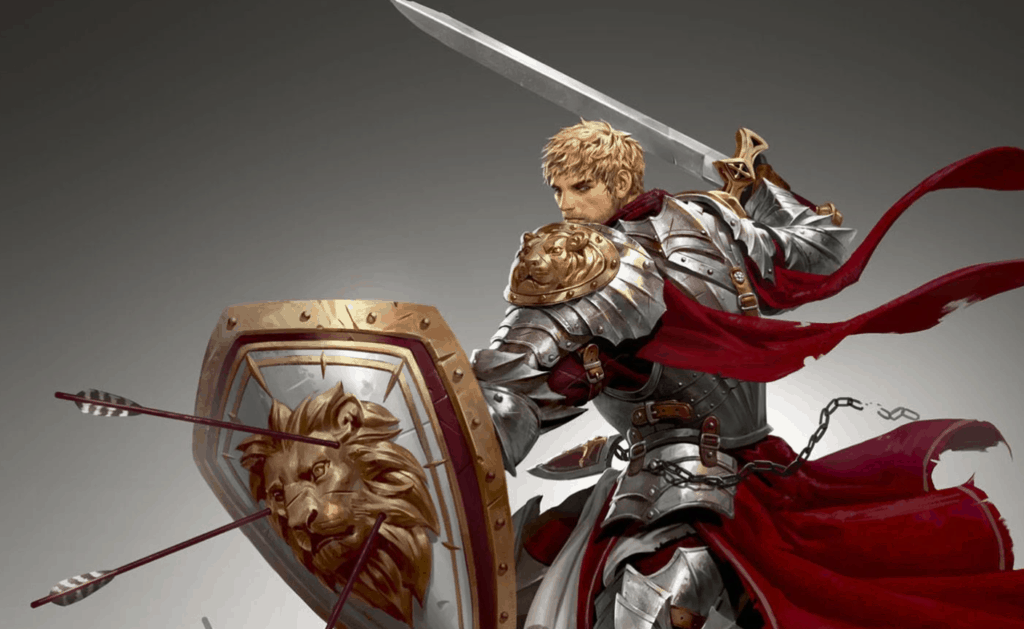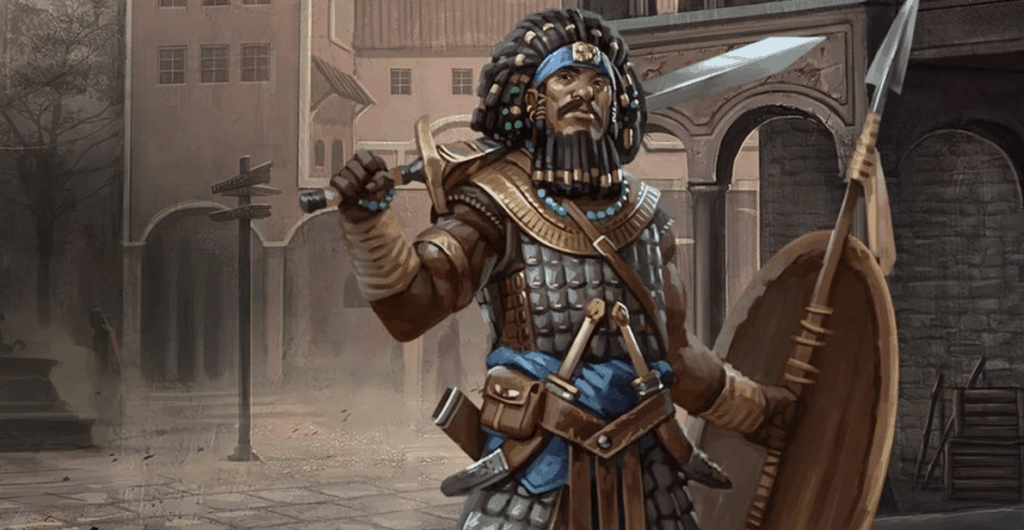Swords! Let’s start with a fact, shall we? The best weapon throughout history was the sword. And what’s better than a sword… a really big one! Because when talking about D&D weapons, size does matter.
So, if you want to venture yourself into dark dungeons or fight your way through a battlefield full of orcs, you may want to bring something worthy of war. But no, we are not here to talk about the great sword, but the adaptable middle brother: The longsword.
Welcome to a Guide to Longswords.
Ambiguous origin
The longsword is a term that’s usually used to describe a type of late Medieval and Renaissance European sword, with a double-edged blade and a cruciform grip. It’s important to take into account that this term is ambiguous and is used to refer to a plethora of different types of swords in medieval Europe, with their own specifics such as place of origin, period and physical characteristics.
In the case of DND, the better term to describe the weapon that the Players Handbook (PHB) is referring to, would be the bastard sword. In reality, the longsword was a two-handed sword and the bastard sword was a one-handed sword that could be used with one or two hands, depending on the user, costumes, circumstances, etc. In a bit, we will be seeing the mechanics of the weapon and why this term could be better fitting.
Even if that’s the case, the term “longsword” has been stable for DND since the first edition with mostly the same characteristics: A sword that fits in one hand but is better when used with two.
Always take into account that even if this is the case for the term “longsword” you could talk to your DM to reflavour your weapon as you see fit. For example, using the mechanics of the longsword, but saying is a katana.

Breaking down the rules
On page 149 of the PHB is the table with all the weapons that the basic rules for DND offer. There we can see that the longsword is a Martial Melee Weapon with 1d8 slashing damage and the Versatile (1d10) property.
It is good to have in mind that the battleaxe is mechanically identical to the longsword so everything that we’ll discuss here applies to that weapon too. Warhammers just change the damage type so, except for the slasher feat, and the monster’s specific resistance or immunities, everything else applies for them too.
Limitations with the longsword
Being a Martial Weapon, it needs a certain kind of training to be able to use it properly, which means adding your proficiency bonus to the attack roll. The classes that can take advantage of their training are Barbarians, Fighter, Paladin and Rangers. Nonetheless, Bards and Rogues have proficiency in longswords specifically.
Furthermore, there are specific subclasses that gives proficiency in Martial Weapons such as Hexblade for Warlocks; Bladesinger for Wizards; War, Tempest and Twilight Domain for Clerics, Kensei for Monks; Battle Smiths for Artificers; etc. Also, you can gain proficiency with some races/subraces such as High and Wood Elves, Hobgoblins, Giths, etc. And the list goes on with every book.
As we see, almost everyone can use a longsword, but let’s pull this sword out of the rock and see what else we have.
As with all melee weapons without the finesse property, you use your strength modifier for attack and damage roll, so if you are using a low strength class, you will get into some issues. Some classes and subclasses, even if they are proficient with the longsword, such as Rogues or Bladesingers, usually rely on their dexterity for both AC and abilities, and there is so much room for choosing and boosting ability scores.
The proper way to use a longsword
Is time for some mid/maxing. The name of the game in adaptability, longswords have the versatile property for something, after all. Their damage for one hand is excellent, but it gets better when used with two. Now is when we get the opportunity to choose, and choosing is in the heart of the longsword.
Let’s do some exercise. You are going with your group through a hard dungeon, a few steps ahead lay the big treasure. But Wait! The dragon is there, ready to eat any fool who enters without a plan. You’ve been chopping thru all his little kobolds with ease, using your longsword with both hands to maximize damage. But this ain’t no little lizard, it could wipe up your party.
You need to stand your ground. So you grab the shield from your back giving you a +2 to AC and fight with your characteristic sword and board style, at the front line. You’ll give up some damage, you’ve been using the versatile feature of the weapon to attack with 1d10 with each slash, and now it’s reduce to 1d8. A fair trade, seeing that you gain some juicy AC in return.

Useful variations
As you see, the longsword can be an excellent weapon, if used correctly. But sometimes it needs a little boost. Not everything can be chopped down the same way. There are some monsters with resistances or immunities to slashing damage, which means they halve or outright negate (respectably) the damage from weapons with that damage type.
Almost always, if you find a magic weapon, those resistances can be overcome easily. But if your DM doesn’t give you even a +1 longsword, there are other things you can do. There are monsters with resistance that can be surpassed, bathing your weapons in silver for 100 gp approximately.
You can also have an artificer in the party that can infuse your weapons with some magic. Some classes/subclasses have abilities that make their attacks count as magic, such as the Paladin with the Sacred Weapon channel divinity or the Kensei monk with his Magic Kensei Weapons.
Now, the time for Builds
Probably the most important part of the guide. What character would benefit from this weapon, or in other words, what build we can make applying the longsword’s versatility to his highest potential. With this in mind, we are looking at classes/subclasses, races, objects and feats that would synergize with the sword and board playstyle, as this is the best way to use the longsword.
The Bodyguard
With all the cool stuff that Tasha’s Cauldron of Everything brought to the game, one was adding even more Battlemaster’s maneuvers and entire “presets” of characters. The Bodyguard is a fighter build that grabs almost everything you need to be the real tank of the group, stopping blows to your allies with things like the Protection and Interception fighting styles, as well as the Bait and Switch and Goading Strike.
Adding to that, the feat Alert to get fast into position and Sentinel to stop foes on their tracks. Pick a Half-Orc race to be even more sturdy, and there you go. Your DM will love you…

Just Paladin
Paladins are a strong class in general, and they fit right in with the defender playstyle. As with the Bodyguard, pick the protection fighting style to defend your allies and stay front line as long as necessary. The big difference with the fighter is that Paladins have a little scary thing called Divine Smite. You may not be as protective as the fighter variance, but you’ll be much more threatening to your foes. Add the Vengeance Paladin subclass and crit as much as you like with Vow of Enmity.
Conan, the barbarian
Inspiring yourself with a classic is very useful. The barbarian doesn’t need armor; he IS the armor. Give him a longsword and you essentially have Conan. You could use the usual shield, but we can change a bit for this. We’ll go with the Human Variant and pick the Dual Wielder Feat, giving you the change to use two longswords to attack in each turn. Then, at fourth level, we can pick the Fighting Initiate feat from Tasha’s to grab Dual Weapon Fighting and add the strength to the damage. Granted, this looks better with axes, but mechanically is the same.
Other options
I would like to remind you that you should always make the character you like to play, even if mechanically is weaker, you should always look for what’s better for you. Clerics and Hexblade Warlocks can be powerful choices for a longsword user too, but pick the character you like the most.
You can be a College of Valor’s Bard that uses some of their strength instead of dexterity, or a Rogue that wants to be closer to battle with sword and shield. They will be suboptima,l but DnD offers much freedom to make the character you want.
Get inspire with your weapon
This last part will be just some ideas that might give you inspiration regarding how to role-play a longsword user.
Great longswords of history
The “Wallace Sword” was use by William Wallace to fight against the British in the First War of Scottish Independence. An excellent, balanced and strong two-handed longsword. Maybe your PC is a liberator who uses his sword as a tool to liberate his people.
The “Writhen Hilt Sword” is a beautiful masterpiece and his origin is somewhat unknown. Maybe your character is an archeologist that found this weapon in one of his expeditions and is in a quest to find his true origin because he’s trapped by his beauty.
The Joyeuse is said to be the sword of Charlemagne. It’s covered in joules, and it was used in ceremonies for a long time. Maybe your character is an Oath of Conquest Paladin that wants to live up to a legendary figure of his world.
Fiction and Mythology
“Excalibur”, probably one of the most famous swords of history. Some depictions show it as a greatsword but most times is seen as a longsword with magical properties. Stuck in a stone, lays a powerful artifact that your character seeks. Holding the power to do amazing things and grant his user the title of king.
To all Game of Throne’s fans, I assume you remember the importance of Valyrian Steel Swords. We have the two sword that were formed from “Ice” the greatsword of Ned Stark: Widow’s Wail and Oathkeeper. The first belonged to a pretty messed up child, but the second reach the hands of the most skilled swordswoman in the continent. Maybe you are a hulking woman with strong bonds and an unbreakable word. You named your sword based on a promise that you keep close to your heart.
Anyone who saw Dragon Ball Z probably agrees that Trunk’s Sword, “The Brave Sword”, was one of the coolest perks of the character. Maybe your character is already a powerful individual, like a sorcerer, and his swords helps channel the huge power running through his veins.
Magic swords from the world of DND
“Holy Avengers” are +3 swords, especially effective against fiend and undead. Some of the most famous examples are longswords of the like of “Crusader”, “Hill Cleaver” or “Pale Justice”. Your classic Paladin, unafraid to go into battle against the most awful creatures of the universe.
Classic swords of DND are the “Flame Tongue” and the “Frostbrand”. Simple but effective, elemental power attached to a blade. Burning or freezing your foes to the dead might be your thing, and you don’t have to be an Evocation Wizard to do it. Just talk to your DM for one of these.
And we can’t end without one of the strongest items in the game. The “Vorpal Sword”. Just chops heads clean. This is the sword that Alice use against the Jabberwocky. This is a legendary Item, so you won’t see it until late game, but it could make for a good adventure to look for it.
FAQ
Question: How much does a longsword cost in DND
Answer: As stated in the PHB page 149, the cost of a longsword is 15 gp. As always, you can take it as part of your starting equipment depending on the class or using the Starting Wealth by Class system for buying it.
It’s important to remember that, during the campaign, you could find ways to change your weapon if you are not happy to your current one
Question: Can I wield two Longswords in DND 5e?
Answer: The short answer is yes. But keep in mind that the longsword doesn’t have the light property so, in order to even be useful, you’d need the dual wielder feat to attack with your off-hand with your bonus action. Remember though that you won’t add your strength modifier unless you also have the two-weapon fighting style from your class.
It’s a bit complicated, but you can do it, off course you wouldn’t be able to use the versatile property of the longsword, nor use a shield.
Question: Can I use my dexterity when attacking with a longsword?
Answer: Short answer, no. All melee weapons use strength to attacks and damage rolls. The only melee weapons that use dexterity are the ones with the finesse property.
With that said, you could find a special kind of longsword or a magic longsword with the finesse property. Off course this would be homebrew and campaign and DM depending. So, talk to your DM for something like that.
- Shadow Blade 5e Guide: The Edgy Sword - October 31, 2022
- Aid 5e Guide: Free Points! - October 1, 2022
- Flaming Sphere 5e Guide: Running Orb of Fiery Chaos: - October 1, 2022

